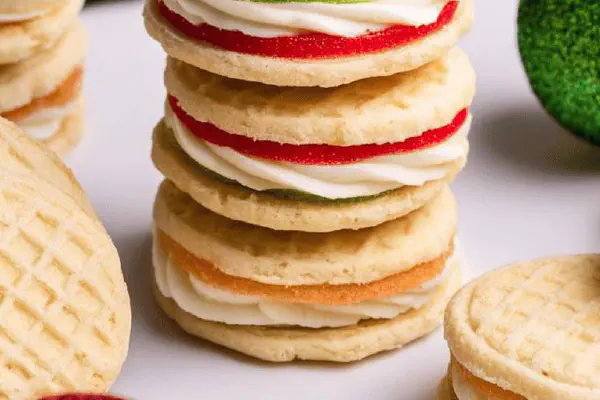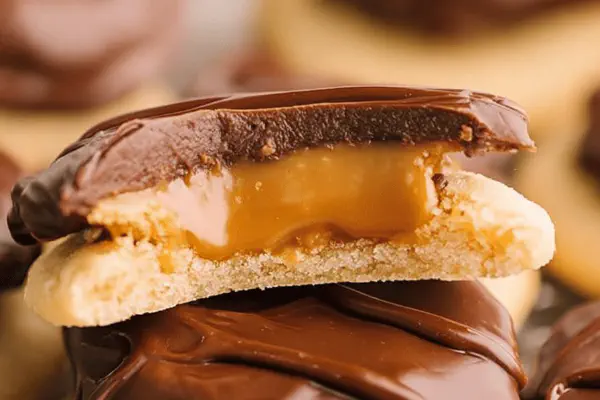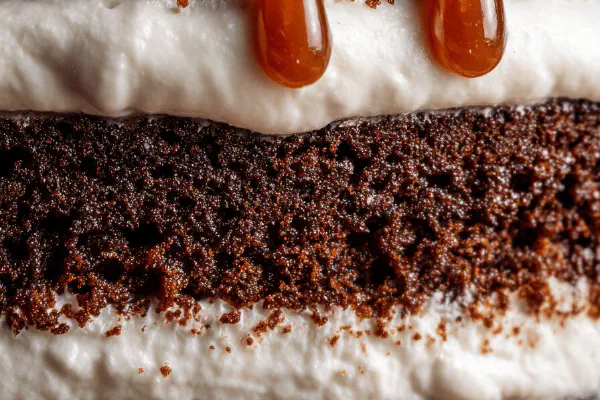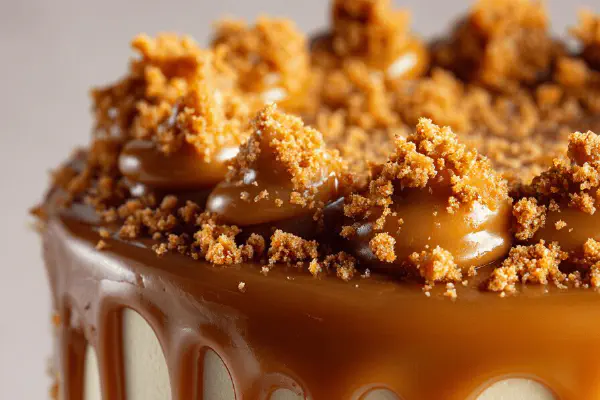Checkerboard Cake
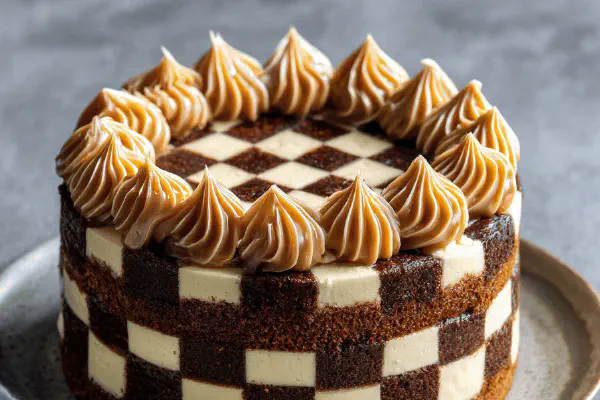
By Emma
Certified Culinary Professional
Ingredients
Caramel
- 180 ml (3/4 cup) granulated sugar
- 75 ml (1/3 cup) water (divided)
- 120 ml (1/2 cup) heavy cream 35%
Frosting
- 175 ml (3/4 cup) unsalted butter, softened
- 480 ml (2 cups) powdered sugar
- 5 ml (1 tsp) white vanilla extract
Cake
- 240 ml (1 cup) unsalted butter, softened
- 295 ml (1 1/4 cup) granulated sugar
- 4 large eggs
- 10 ml (2 tsp) pure vanilla extract
- 500 ml (2 cups) all-purpose flour
- 10 ml (2 tsp) baking powder
- 60 ml (1/4 cup) almond milk (or regular milk)
- 50 ml (3 tbsp) unsweetened cocoa powder
- 40 ml (2 1/2 tbsp) almond milk (or regular milk) extra
- Cocoa powder for dusting
About the ingredients
Method
Caramel
- 1. Pour sugar and half the water into a heavy-bottomed pan over medium heat. No stirring — just swirl gently. Watch the color shift: first clear, then amber then deep golden caramel scent wafts. When deep amber with brown edges, pull off heat fast.
- 2. Carefully add remaining water and warm cream — expect vigorous bubbling, steam. Stir gently, return saucepan on low just to combine. Don’t boil or it will seize. Set aside to cool completely. Caramel should be pourable but thick.
Frosting
- 3. Beat softened butter in large bowl on medium speed until creamy and lightened, about 3 minutes. Gradually sift powdered sugar, continue beating low speed to avoid clouds.
- 4. Add vanilla. Increase speed to high momentarily to aerate — frosting must be fluffy yet holding shape, no gritty sugar bits. Cover and chill if too soft when assembling.
Cake
- 5. Preheat oven to 175°C (350°F). Grease and flour two loaf pans roughly 22 x 12 cm (9 x 5 in).
- 6. In large bowl, beat butter and sugar until pale, creamy — 4–5 minutes; crucial to trap air otherwise cake dense. Add eggs one at a time, beating well after each. Mix in vanilla extract fully.
- 7. In separate bowl, sift flour and baking powder together. Alternate adding dry mix and almond milk to butter-egg mix, beginning and ending with flour. Fold gently with spatula, don’t overmix — batter silky, thick but flowing.
- 8. Divide batter evenly. To one half, fold in cocoa powder plus extra almond milk just until fully dark and uniform. Rich chocolate scent should bloom.
- 9. Pour chocolate batter into one pan and vanilla into the other, smooth tops with spatula. Bake center rack 35–40 minutes, test doneness with toothpick — comes out clean or with few crumbs.
- 10. Let cool 15 minutes, then invert onto racks. Trim domed tops with serrated knife for flat surfaces. Once fully cool, slice horizontally into two layers each, yielding four total cake rounds (2 vanilla, 2 chocolate).
- 11. Layer cakes alternating vanilla and chocolate rings. Spread a thin layer of caramel between each layer to glue. Don’t oversoak or cake soggy. Square off edges for neatness.
- 12. Cut these layered rounds vertically into three long strips. You'll get three checkerboard slices alternating vanilla and chocolate segments lined up.
- 13. Lay one slice flat. Spread caramel evenly atop. Stack other slices alternating colors to form checkerboard pattern when viewed from side. Press gently to fuse.
- 14. Spread buttercream frosting evenly over entire cake. Optionally tint a small portion with pastel food coloring and swirl lightly on top to mimic a subtle marbled effect.
- 15. Chill slightly to set frosting. Dust sides lightly with cocoa powder for rustic finish.
Cooking tips
Chef's notes
- 💡 Caramel needs close eye on color shifts. First clear, then amber then deep gold. Any bit burnt – bitterness ruins layers. Stirring no no; swirl pan gently. Adding cream water slow avoids seizing. Heat moderate keeps caramel pourable but thick. Once off heat use quick, cool before spreading.
- 💡 Butter for frosting must be soft, room temp. Cold butter clumps, ruins texture. Beat longer than feels needed, pale and fluffy at least 3 minutes, sift powdered sugar before adding. High speed momentarily aerates; stops gritty texture. Chill if too soft when assembling. Pastel colors optional but use sparingly.
- 💡 Trim domed cake tops for stackability. Rounded tops cause lopsided layers and shaky cake. Use serrated knife, gentle sawing motion. Slice horizontally when fully cool. Cool layers 15 min before moving; warm cake tears or crumbles easily. Stack rings alternating vanilla chocolate, spread caramel thinly to glue, not drown layers.
- 💡 Divide batter evenly, fold cocoa and extra almond milk into half only. Batter silky and thick, avoid overmixing or layers dense. Almond milk swaps whole milk seamlessly adding slight nuttiness. Butter and sugar beaten until very pale traps air, crucial for texture. Bake 35–40 mins, test with toothpick checking clean or few crumbs.
- 💡 Cut layered rounds vertically into 3 strips for checkerboard slices. Press gently after stacking layers with caramel glue to fuse sides. Spread buttercream over cake thin and even; chill slightly before dusting cocoa. Frosting air whipped for light texture but hold shape. Cocoa powder dusting optional for rustic look, enhances visual depth.
Common questions
Why does caramel seize sometimes?
Usually heat too high or adding cream too fast. Stir gently, add liquids slow. Water ratio matters. If it seizes, can try reheating gently but texture off. Sometimes scrap for glaze instead. Keep heat controlled.
Almond milk swap okay?
Sure. Any milk close to regular thickness works. Plant-based or dairy fine. Adds subtle nuttiness here. Avoid watery milk or thin alternatives; batter texture suffers, more folding needed. Whole milk or 2% work without issue. Adjust liquid slightly if too thick or thin.
Cake top domes causing problems?
Trim straight off with serrated knife once cool. Domes mess stack, lopsided effect. If crumbly, chill layers before trimming. Cooler cake edges slice cleaner. Skipping trimming means unstable cake, uneven checkerboard effect. Always prep layers flat and equal thickness.
Best way to store finished cake?
Wrap leftover cake airtight, fridge best to keep caramel and frosting stable. Cake can dry out — avoid long storage. Freeze in slices wrapped well, thaw slowly in fridge before serving. Leftover caramel refrigerate separately, rewarm slightly to spread again.
